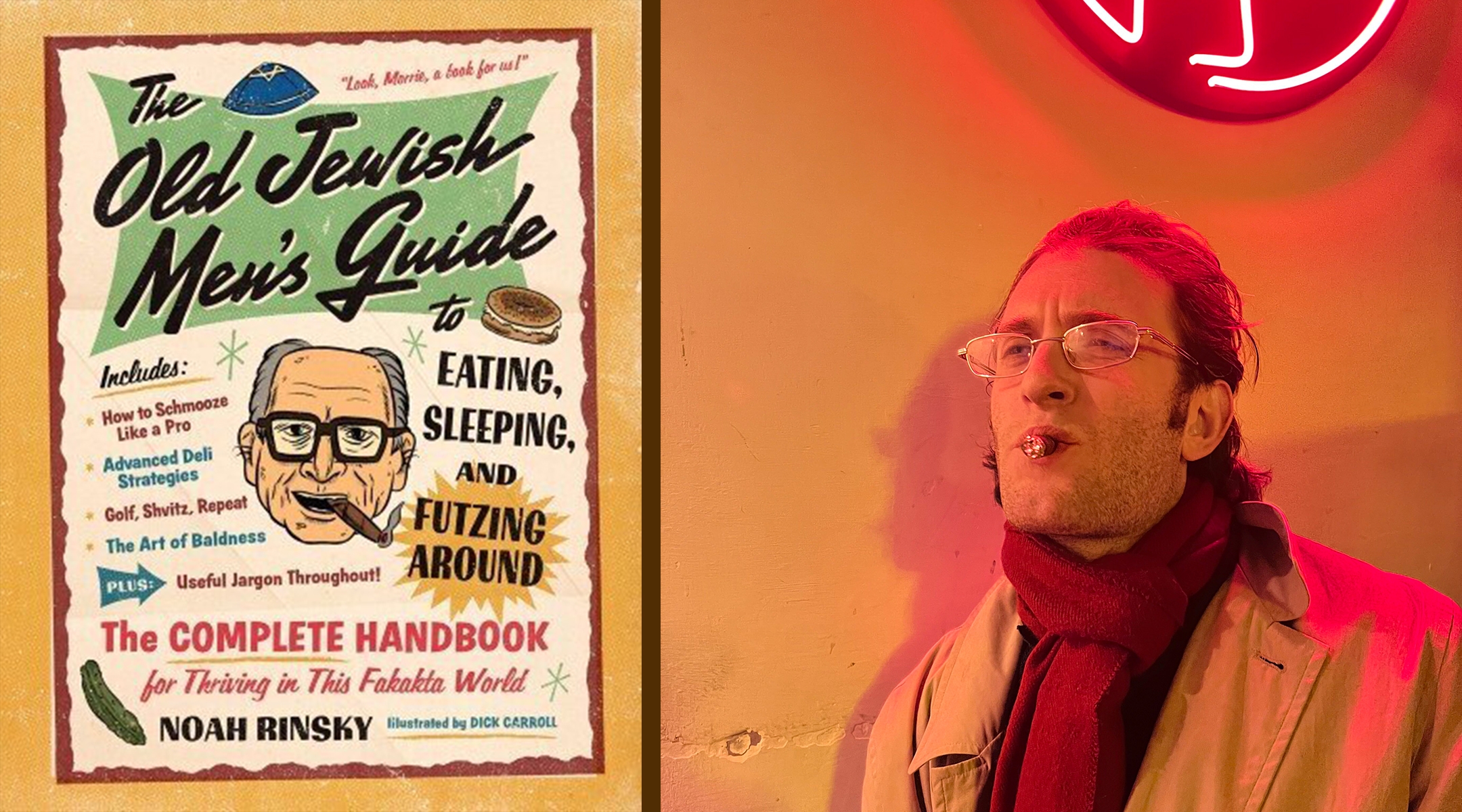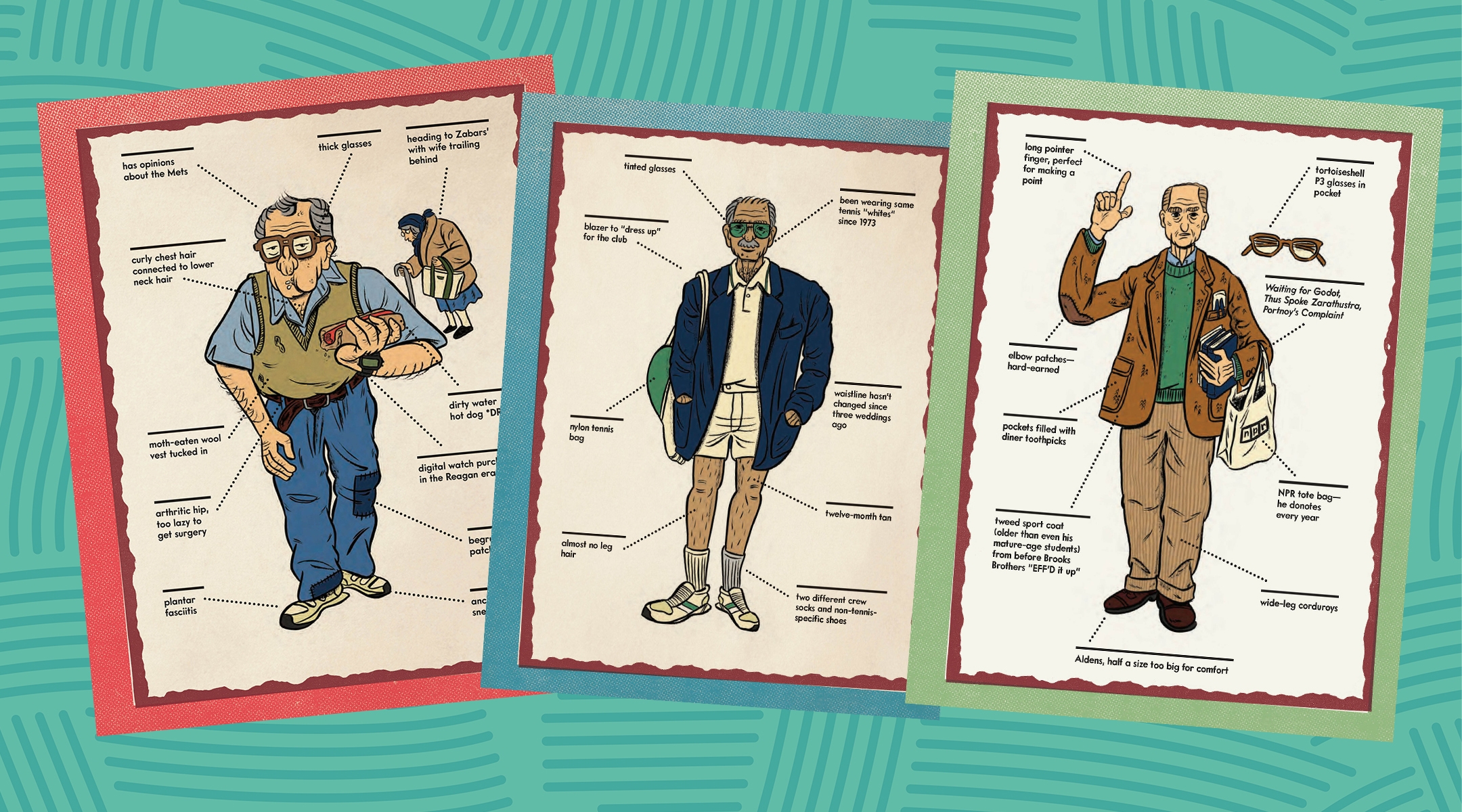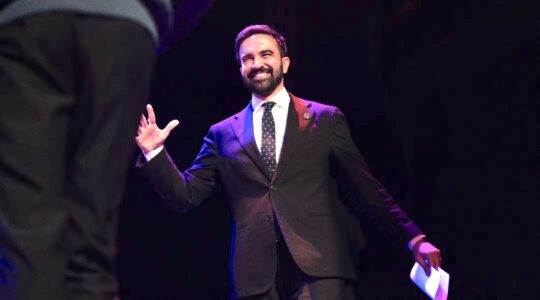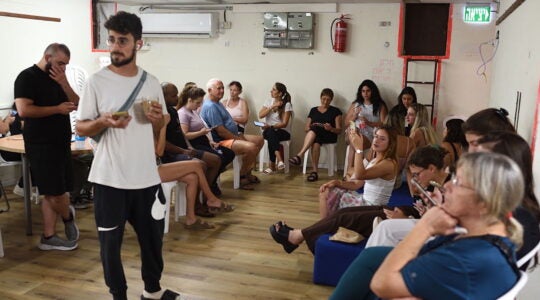If you’re looking for pro tips for ordering at a busy Jewish deli, being a zayde or schmoozing “like a pro,” then Noah Rinsky’s forthcoming humor book is for you.
“The Old Jewish Men’s Guide to Eating, Sleeping and Futzing Around,” which hits stands next week, is an extension of Rinsky’s popular social media account, Old Jewish Men of New York.
Rinsky, 35, a Colorado native who now lives in Park Slope, Brooklyn, started the account in 2016. His aim was to document his father’s eccentricities in daily life, though the account quickly evolved to celebrate all sorts of elderly Jewish men around New York City.
In 2021, he branched out into clothing, hawking tongue-in-cheek merchandise on the Old Jewish Men website: hats that say “Polo Ralph Lifshitz,” honoring designer Ralph Lauren’s birth name; a Mets-style jersey that reads “Meats,” and a bedazzled T-shirt that says “Pickle Princess” that was recently worn by actress and singer Selena Gomez.
“First and foremost, it’s a clothing company, but I guess it’s a lifestyle brand,” is how Rinsky, who is married to Vogue writer Liana Satenstein, describes Old Jewish Men.
These days, Rinsky’s Instagram account boasts 392,000 followers, plus an additional 200,000 on TikTok. Much of the account revolves around photos and videos of, yes, Jewish men at various locations around New York as they taste-test bagels, sample snacks at Costco and Trader Joe’s, and stage protests about the high price of smoked salmon and the city’s lack of public restrooms.
One regular is David Roffe, a 72-year-old retiree who lives in the Rockaways. On OJM’s Instagram, you can watch Roffe show off a “Mommy’s Little Matzo Ball” T-shirt at Katz’s Delicatessen and sample snacks at Costco and Trader Joe’s. Rinsky connected with Roffe when his wife answered an open casting call to film (old Jewish) man-on-the-street content.
“Dave, for whatever reason, feels like everybody’s grandpa. That really strikes a chord with people,” Rinsky said. “He is a grandfather. He’s a terrific grandfather. He’s just so lovable and funny.”
Now, Rinsky is putting the years of wisdom he’s gleaned from the cast of characters he’s met over the years between soft covers. With illustrations by Dick Carroll, the book helpfully identifies types of OJM, like “The Grumpy Intellectual,” who wears tortoise shell glasses and carries NPR tote bags, and the “Soft Spoken L.A. West Coasters,” characterized as “mostly New York runaways who fled for sunnier skies” and sport mismatched crew socks.
Ahead of the book’s publication, which included a buzzy book launch party on Tuesday at J. Press Clothiers in Midtown, the New York Jewish Week spoke with Rinsky about the evolution of Old Jewish Men, the way stereotypes do — and don’t — play into the brand, and how its content gets made.
This interview has been lightly edited for length and clarity.

Noah Rinsky, 35, is the author of “The Old Jewish Men’s guide to Eating, Sleeping and Futzing Around.” (Workman Publishing, Liana Satenstein)
What has it been like to work on this book and eventually publish it?
It’s a great sense of relief. This book was a lot harder than I thought it would be. I’d written short stories and I wrote a novel before this, but I’d never written a book like this that needed jokes on every page. It’s very tight — you really can’t have much fat on it at all. The hardest part was that at the end of the day, Old Jewish Men is the same joke over and over and over again, just told in different ways. Iterating on that joke and finding new ways to make it fresh was always a challenge, but I hope that we succeeded and hopefully it didn’t get stale. Either way, the book’s not meant to be read straight through, it’s one that you pick it up, you have a laugh and then you put it down.
Why did you start the Old Jewish Men of New York account?
I was taking pictures of my dad originally, and the original account was called “Dad Around the House,” with videos of him napping and doing kind of strange exercises and talking to my mom. When I got back to New York, I was living in the Lower East Side with my brother and I just continued it. I knew that there was something with Old Jewish Men. It was the early days of Instagram.
At the time, there was a more morose spin on it. The account was more about mortality — it wasn’t quite as much of a celebration of Old Jewish Men as it is now. It was kind of “the immigrant struggle,” as if we had just arrived on the Lower East Side, that was kind of the attitude.
For a long time, it was very much just a hobby that I was doing. There was no trying to monetize it or anything like that. In 2018, I did a purely community-based event at Stanton Street Shul called “Lox, Scotch and Talk.” People from the neighborhood showed up, the event was sponsored by Raskin’s fish, and we had a jazz trio. It was a lot of fun — but no one had heard of Old Jewish Men. Everyone was just happy to be there and just kind of be talking about the neighborhood, which I thought was so pure and fun. During COVID, I did a line of T shirts illustrated by Cerise Zelenetz. They sold out very quickly and I realized that there was something there. I started working with my friend Bryan [Seversky] who had a background in e-commerce and who became my business partner, and we worked on building it into a real clothing brand company.
What type of credibility do you have to write the Old Jewish Men’s guide?
I don’t think that I’m, by any means, the most qualified person to write some iteration of an old Jewish man’s guidebook, but I’ve certainly spent enough time with old Jewish men to know the terrain. So as far as credibility, will I ever feel qualified to do anything? Not 100%, but like Philip Roth said, “I did the best I could with what I had.”
I interviewed a lot of different old Jewish men for the book. A lot of my friends’ dads, my uncle, my own dad — I talked to pretty much every different kind of shade of old Jewish man that I could find. I read quite a few books for research. I read a lot of Rich Cohen’s books, Norman Mailer’s books and a biography of Sam Fuller [the Jewish director and screenwriter].
I know the book is supposed to be funny, but how do you balance representing Ashkenazi Jews vs. just stereotyping them?
As far as stereotypes, I try not to think about it and let Dave [Roffe] or Aaron [Cohen] or whoever the guys are [in the OJM videos] just lead the content. I’m not forcing them to care about something that I care about, [just] because I think it’s funny. If Dave doesn’t care that Costco does or doesn’t have raw onions as a condiment at the food court, I can’t make him care, but he does. When I told him about it, he was like, “This is ridiculous, how can they be doing this to us?” One could say I’m just hitting this “Jews are really price conscious people all the time” and I’m continuing to kind of milk that vein. But if you ask these guys what their biggest concerns are and what they care about, this is what they’re talking about naturally.
I just kind of listen to what they’re saying. When we were filming 2021 to make on-the-street content, there was a huge problem with these guys that there was no place to use the bathroom. Then we took them out for lunch, and they’d be upset about the prices. So this stuff isn’t just stuff I’m cooking up because I think it’s provocative, it’s mostly just real issues that happen to be funny.
What’s it been like to work with a different generation?
It’s been great. I kind of forget now that they’re older than me. They’re just my friends. I talked to Dave or Aaron almost every day. I’ve had them over to my house just to hang out and go to their houses. They’re just guys who I’m friends with now who happen to be older than me and I happen to be directing them, but when the cameras are off, we’re just hanging out.
The New York Jewish Week brings you the stories behind the headlines, keeping you connected to Jewish life in New York. Help sustain the reporting you trust by donating today.





